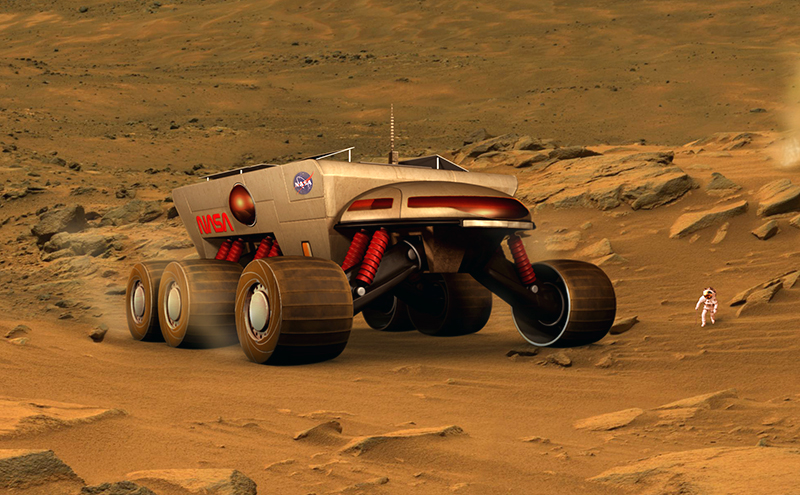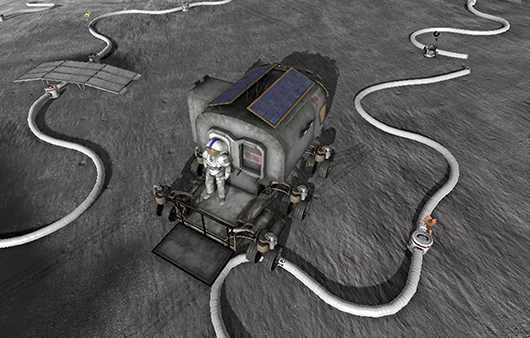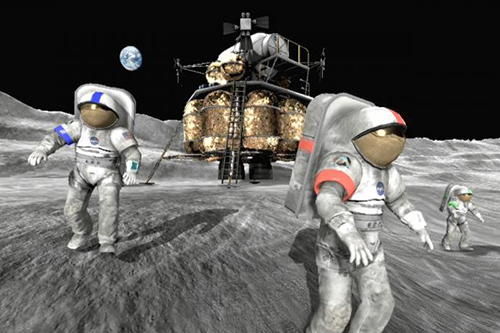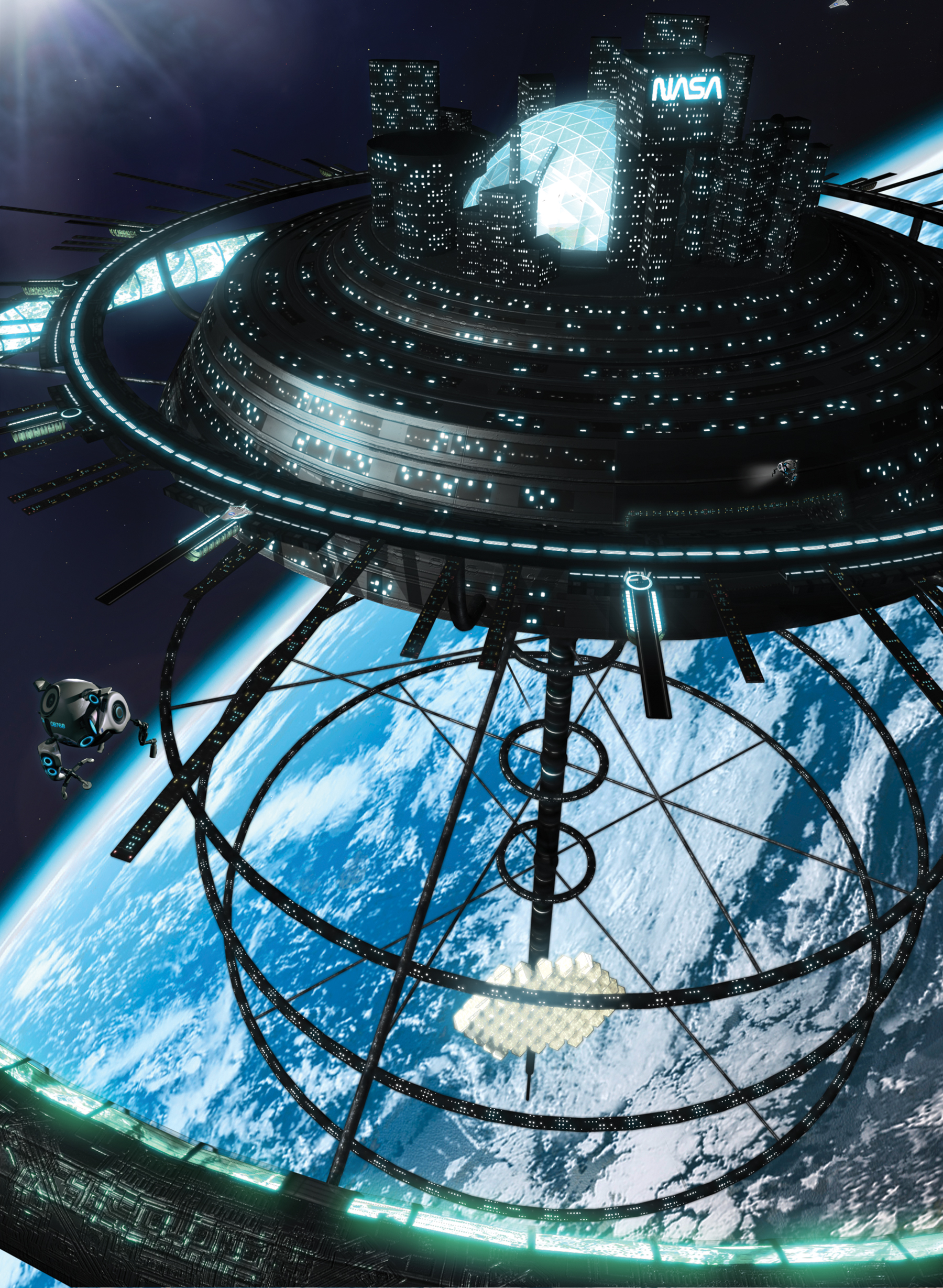
NASA Missions Inspire Online Video Games
NASA Technology
Fast forward to 2035. Imagine being part of a community of astronauts living and working on the Moon. Suddenly, in the middle of just another day in space, a meteorite crashes into the surface of the Moon, threatening life as you know it. The support equipment that provides oxygen for the entire community has been compromised. What would you do?
While this situation is one that most people will never encounter, NASA hopes to place students in such situations—virtually—to inspire, engage, and educate about NASA technologies, job opportunities, and the future of space exploration. Specifically, NASA’s Learning Technologies program, part of the Agency’s Office of Education, aims to inspire and motivate students to pursue careers in the science, technology, engineering, and math (STEM) disciplines through interactive technologies. The ultimate goal of these educational programs is to support the growth of a pool of qualified scientific and technical candidates for future careers at places like NASA. STEM education has been an area of concern in the United States; according to the results of the 2009 Program for International Student Assessment, 23 countries had higher average scores in mathematics literacy than the United States. On the science literacy scale, 18 countries had higher average scores.
“This is part of a much bigger picture of trying to grow skilled graduates for places like NASA that will want that technical expertise,” says Daniel Laughlin, the Learning Technologies project manager at Goddard Space Flight Center. “NASA is trying to increase the number of students going into those fields, and so are other government agencies.”
Partnership
In 2004, Laughlin began researching the idea of a Massively Multiplayer Online Game (MMOG) to attract young people and foster their interest in STEM subjects. Used as a formal or informal educational tool, an MMOG could help young people to grasp complex concepts in STEM areas and then transfer their understanding to practice. Because today’s generation of young people spend a large amount of time playing video games, the demographic is already familiar and comfortable with the technology. Laughlin thought an online game could be a successful method of exposure to STEM because virtual environments can provide scientifically-accurate simulations where players can experiment with chemical reactions, practice operating and repairing equipment, and even experience microgravity (virtually).
Laughlin explains, “A virtual space gives a sense of being in a shared space, like a real place. Our brains are geared to process the world in three dimensions and virtual worlds are built in three dimensions, so our brains jump to processing in the same way as in the real world. By creating a real, life-like space, it impacts like real life, and everything done there encodes in memories more firmly.” As an added benefit, MMOGs have been shown to enhance skills like strategic thinking, interpretative analysis, problem solving, plan formulation and execution, team-building and cooperation, and adaptation to rapid change.
In 2009, the Learning Technologies program, along with Goddard, Marshall Space Flight Center, and NASA Headquarters, combined efforts to provide funding for Army Game Studio, of Redstone Arsenal, Alabama, and Virtual Heroes of Applied Research Associates, in Raleigh, North Carolina, to develop an online 3D video adventure that uses NASA content—specifically, NASA lunar architecture plans—as the basis for an engaging, inspiring, and fun game. The result was Moonbase Alpha.
Benefits
Released in July 2010, Moonbase Alpha was downloaded nearly 300,000 times in its first 8 months, and won the “Best Government Entry” in the Serious Game Showcase and Challenge at the 2010 Interservice/Industry Training, Simulation and Education Conference.
“We are in the top 10 percent of games as far as popularity goes. Moonbase Alpha has been wildly successful,” says Laughlin.
Available through a commercial network on the Internet, Moonbase Alpha offers 20 minutes of game time during which players can use robots, rovers, and repair tools to help restore the life support system at the lunar base. Because scores are based on the amount of time spent to complete the task as well as proper use of available resources, players are encouraged to form teams and work together. By using voice over communication and an online chat feature, players can communicate and coordinate their efforts with up to six people over a LAN or Internet connection.
On the heels of the success of Moonbase Alpha, Laughlin and others at NASA are pursuing an even larger initiative—an MMOG entitled Astronaut: Moon, Mars, and Beyond. Three companies are working together to develop a fun and inspiring MMOG with 100 hours of game time, focused around a variety of real NASA engineering and science missions. Project Whitecard Inc. of Canada; WisdomTools of Bloomington, Indiana; and Virtual Heroes formed a joint company called Astronaut: Moon, Mars, and Beyond LLC, and then signed a Space Act Agreement with Goddard to allow the developers to consult with NASA to bring real astronauts, scientists, and other people involved with space exploration into the game, as well as incorporate realistic and historical situations.
The plan for the expanded game, says Laughlin, places an emphasis on STEM education, but the fun factor must come first. “There were 800 pages of public input saying this kind of game had to be fun. In the history of educational games, almost all of them have been failures because they were developed under the premise that you want people to learn. If the game play comes second and the goal to teach comes first, it turns out to be a lousy game. The game must be fun,” he says.
The secret to being fun, continues Laughlin, is that a game must have rules, keep track of winning or losing, keep score or another measure, provide some sort of challenge or adversarial condition, and be low stakes. Khal Shariff, the creative director of Astronaut: Moon, Mars, and Beyond LLC, and chief executive officer of Project Whitecard Inc., said the game will include all of that and much, much more.
“Not only will we use the latest technology to drive learning goals, we will also use the best game engine to depict our solar system and a new space station called The Arthur C. Clarke Astronaut Academy. Never before has the ability existed for the public and students to experience the valleys on Mars or the thrill of a launch with such high fidelity,” says Shariff.
Astronaut players will create their own characters, such as an engineer, physicist, or pilot, and as the characters are developed, players working in teams can unlock new activities, tools, and levels. Players learn how to use technology, build structures, and explore their surroundings through their adventures infused with science, technology, engineering, mathematics, and physics. For example, in one of the higher levels of the game, players compete to be the first astronaut team to arrive on planet Mars. Not only do they have to build a manned science vehicle to land on Mars, but they must also plan and maneuver a successful landing, explore their surroundings, and learn to live on the planet, all with inherent realism.
Targeted to students from age 13 to college-age, the game encourages players to form teams of three or four. Shariff says it is designed as a meritocracy where power goes to those with the highest intellect and strategic thinking. “The better you are at science and engineering, putting things together, math, and physics, the more gear you can access and build yourself,” he says.
In its final form, Astronaut: Moon, Mars, and Beyond, with the first chapter entitled “Astronaut Academy,” will feature game play in the asteroid belt, on Mars, and in near-Earth orbit, but it will also be a social game where players can spend time building rovers, customizing space suits, and constructing their own bases. Eventually, the developers plan to release more areas of the solar system as new additions to the game.
In the meantime, curricular support materials are being developed so Moonbase Alpha can be incorporated into formal education, and a number of schools have already signed up to use Astronaut: Moon, Mars, and Beyond for classroom education. With the pilot scheduled for release by late 2011, Shariff says the company expects Astronaut: Moon, Mars, and Beyond to have between 2 and 5 million players within the first year.
“If we can attract people when they are young, using their mediums of video games and social networking,” Shariff says, “it will develop their love for this kind of stuff, just as Buck Rogers, Star Trek, and Carl Sagan did generations beforehand.”
Virtual Heroes® is a registered trademark of Applied Research Associates Inc.
video game to help inspire the next generation of scientists, engineers, and explorers. The game has been downloaded nearly 300,000 times, and an expanded version is in the works.

An astronaut stands on a lunar rover in Moonbase Alpha, a video game based on NASA lunar architecture plans. Army Game Studio and Virtual Heroes developed the game with NASA funding.

Released in July 2010, Moonbase Alpha was downloaded nearly 300,000 times in its first eight months. Here, astronauts stand outside the lunar lander in Moonbase Alpha.

The space station shown here, “The Arthur C. Clarke Astronaut Academy,” is from a new game called Astronaut: Moon, Mars, and Beyond, which is being developed through a Space Act Agreement.

Astronaut: Moon, Mars, and Beyond, will feature game play in the asteroid belt, on Mars (as shown here), and in near-Earth orbit.













